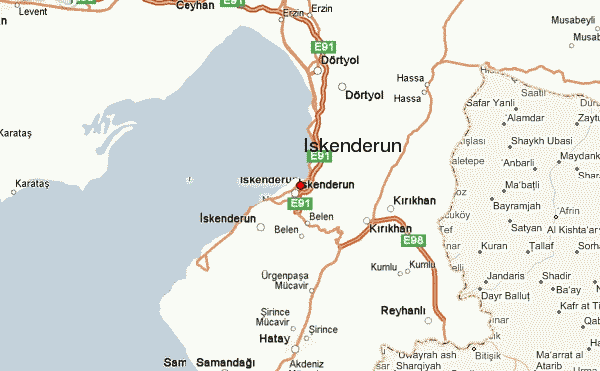Hatay State
Hatay State (Turkish: Hatay Devleti, Arabic: لواء الإسكندرونة), also known informally as the Republic of Hatay, was a transitional political entity that formally existed from September 7, 1938 to June 29, 1939 in the territory of the Sanjak of Alexandretta of the French Mandate of Syria. The state was annexed by the Republic of Turkey on June 29, 1939 and transformed into the Hatay Province (excluding districts of Erzin, Dörtyol and Hassa) of Turkey.
History
Formerly part of the Aleppo province of the Ottoman Empire, the Sanjak of Alexandretta was occupied by France at the end of World War I and constituted part of the French Mandate of Syria.
The Sandjak of Alexandretta was an autonomous sandjak (department) from 1921 to 1923, as a result of the French-Turkish treaty of 20 October 1921, considering the presence of an important Turkish community alongside with Arab and Armenian ones. Then it was attached to the State of Aleppo, then in 1925 it was directly attached to the State of Syria, still with a special administrative status.[1]
Turkey under Mustafa Kemal Atatürk refused to accept the Sanjak of Alexandretta to be part of the Mandate and, in a speech on 15 March 1923 in Adana, claimed, probably in projection to the Turkish Historical Thesis, that it was "a Turkish homeland for forty centuries" that "can’t be a captive at the hands of enemy".[2] Turkish politics aimed at incorporating the Sanjak of Alexandretta when the French mandate of Syria would expire in 1935. Local Turks initiated reforms in the style of Atatürk's, formed various organisations and institutions in order to promote the idea of union with Turkey.
In 1936, the elections returned two Syrian independentist (favoring the independence of Syria from France) MP's in the sandjak, and this prompted communal riots as well as passionate articles in the Turkish and Syrian press. Following this, and an intervention of the League of Nations, a new statute came into power in November 1937, the sandjak becoming 'distinct but not separated' from Syria on the diplomatic level, linked to both France and Turkey for defence matters.[1]
In 1936 Atatürk coined the name Hatay for the Sanjak of Alexandretta, and raised the issue of Hatay (Turkish: Hatay meselesi) at the League of Nations. On behalf of the League of Nations, representatives of France, United Kingdom, The Netherlands, Belgium and Turkey prepared a constitution for Hatay which established it as an autonomous sanjak within Syria. Despite some inter-ethnic violence, in the midst of 1938 an election to the local legislative assembly was conducted and it was convoked.
1938 elections
In 1938, the Turkish military went into the Syrian province and expelled most of its Arab and Armenian inhabitants.[3] Before this, Alawi Arabs and Armenians were the majority of Alexandrettas population.[3] Turkey also crossed tens of thousands of Turks into Alexandretta.[4]
Proclamation of independence
On September 6, 1938 the constitution was adopted. It resembled strongly the constitution created by the League of Nations for the Sanjak of Alexandretta. The constitution defined the territory as an independent state called "Hatay Devleti" (Hatay State), divided into four districts (Antakya, İskenderun, Ordu (Yayladağı), Kırıkhan and Reyhaniye (Reyhanlı). Turkish was declared the state language, while French retained a status as a secondary language. Schools teaching Arabic could continue to do so.
On September 7, 1938 the Hatay adopted a flag sketched by Mustafa Kemal Atatürk. On February 6, 1939 the Hatay legislative adopted all Turkish laws, and on March 13, 1939 made the Turkish lira the official currency.
In popular culture
The State of Hatay was featured as one of the main locations in the 1989 film Indiana Jones and the Last Crusade. In the film, the Holy Grail is discovered in an ancient temple within Hatay, although the location used for the external shots of the temple is the Treasury of the ancient city of Petra, actually located in Jordan.
Aside from the name and location, most of the detail of Hatay within the movie is fictionalised - the flag is incorrect, and the state is shown as a monarchy with a Sultan.




